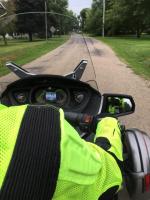|
-
Very Active Member

 Tire pressure recommendations Tire pressure recommendations
I've been trying to find info to support the 18-20 PSI argument for a real car tire on the rear of a Spyder. This is the best I could do. The last sentence is particularly interesting.
This is from a pdf file downloaded from www.lehmantrikes.com/assets/docs/uploads/Manuals/techbook-master.pdf
THE IMPORTANCE OF PROPER TIRE PRESSURE-TECHNICAL ARTICLE WHAT IS THE CORRECT TIRE PRESSURE FOR MY TRIKE?
There has been a lot of confusion and misinformation out there when it comes to tire pressures for trike riders. Most all trikes have a motorcycle tire up front and automotive tires in the rear. The motorcycle compliance label has a recommended pressure for both the front and the rear tires. Now that your motorcycle is a trike are these still the pressures to use? Since we are trying to clear up the confusion and misinformation… the answer is yes and no! Let me explain more fully. We, Lehman Trikes, have always recommended that you maintain the same pressure the motorcycle manufacturer lists on the compliance label for the front wheel. There is no reason to change this pressure. That’s the “yes”. The “no” is a bit more involved. First of all, the two automotive tires like those installed on the rear of your trike are a completely different design than the single motorcycle tire they replace. Now for some history. Lehman Trikes has been building and riding trikes for 25 years. Our founder, John Lehman, and many of the dedicated trike riders that work here have experimented for years trying to find what air pressure in the rear tires gives you the best ride, handling and tire life. What they found and recommended for years was an air pressure in the 20 to 22 psi range worked best. So why, if you look at a current Lehman Trikes Owner’s Manual or the Owner’s Manual for a H-D Tri Glide, do you see a 26 psi recommendation for the rear tires? When I came to Lehman Trikes several years ago one of the things I was asked to do was to confirm with the manufacturer of our tires that they would support our recommendation of 20 to 22 psi air pressures for our application. What I learned is that no tire manufacturer will recommend anything less than 26 psi for standard automotive tires.
Where the 26 psi number came from is an interesting and somewhat involved story. There is a regulatory organization called the Tire and Rim Association (T&RA) which, of course, standardizes specifications for all different applications for tires and wheels (rims). One of the things that they provide is a load carrying capacity for each tire size at different air pressures. In their old reference books they listed load carrying capacities for tire pressures all the way down to 20 psi. I don’t know what year they changed but in 1999 they still listed load carrying capacities down to 20 psi. Do any of you remember the big public fight that went on between Firestone and Ford Motor Co a few years ago? As I recall, people were rolling over in their Ford Explorer’s and Ford and Firestone were vigorously pointing the finger at each other. The final out come was that it was determined that people were reducing the air pressure in their tires to improve ride quality. That would not have been a problem but they failed to increase the pressure when the vehicle was more heavily loaded. As a result, the T&RA elected to eliminate the lower pressure ratings from their reference books. In support of the T&RA, the tire manufacturers will not support running their tires at anything less than 26 psi. So how much difference does it make? Why not just run them at a higher pressure? Running the rear tires on your trike at a higher tire pressure has a dramatic impact on how the trike rides and handles. For each additional psi of pressure you increase the rigidity of the sidewall. At maximum pressure the sidewalls of your tires are quite rigid. Rigid sidewalls will increase the occurrence of the low speed “head shake” inherent in all three wheeled vehicles. They will also transmit more of the bumps in the road to you and your passenger. As you reduce the tire pressure it allows the sidewall to provide additional “cushioning” when riding over irregularities in the road surface. Certainly you do not want to reduce the air pressure too far because that will adversely affect the handling of the trike.
The “cushioning” effect of the sidewalls is, of course, reduced if you are using a tire that has very little sidewall. For example, those 18 or 20 inch rims that look so cool on the back of your trike do all the wrong things for ride comfort and low speed head shake. A standard 15 or 16 inch rim with a properly sized, properly inflated tire will give you the best ride quality and the least amount of head shake. The most commonly used tire on the rear axle of a Lehman Trike is the P205/70R15. As a point of interest, in the 1999 T&RA reference book it lists a load carrying capacity of 1146 lbs for a standard P205/70R15 tire with 20 psi of air pressure.
On the road again...........and forever young!
2013 RT-S SE 5

Yesterday is a cancelled check.
Tomorrow is a promissory note.
Today is cash.......spend it wisely.
 Posting Permissions
Posting Permissions
- You may not post new threads
- You may not post replies
- You may not post attachments
- You may not edit your posts
-
Forum Rules
|







 Reply With Quote
Reply With Quote
